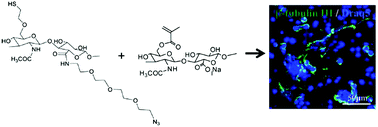Response to di-functionalized hyaluronic acid with orthogonal chemistry grafting at independent modification sites in rodent models of neural differentiation and spinal cord injury†
Abstract
Hyaluronic acid (HA) with one reactive moiety grafted to the backbone is a commonly used matrix in tissue engineering. The addition of a second orthogonal moiety to the backbone allows for greater control in bioactive signal tethering and gelation. In this study, thiol and azide functional groups were grafted to the HA backbone at separate modification sites. NMR, FT-IR, colorimetric assay, and radio-TLC activity were used to confirm and quantify thiol and azide grafting to the HA backbone. Various ratios of di-functional HA (dif HA) and methacrylate HA (mHA) were used to encapsulate mouse embryonic stem cells in order to examine the neural differentiation of the cells. Greater neural maturation was observed in hydrogels containing a higher percentage of dif HA compared to mHA over a six day neural differentiation time course. This formulation was then tested in a contusion spinal cord injury model for biological effect and was found to reduce the ED1+ area in the spinal cord compared to control and allow for host axon extension into the matrix filled lesion area. These results indicate that dif HA is supportive of neural differentiation and can reduce inflammation without additional bioactive signal tethering. dif HA is a promising matrix base for the central nervous system, which should be further developed.



 Please wait while we load your content...
Please wait while we load your content...